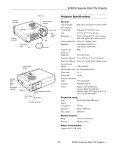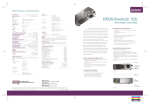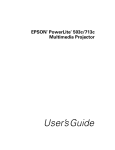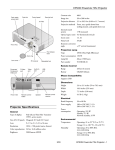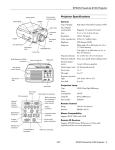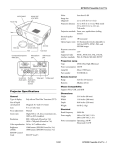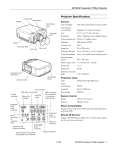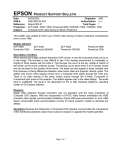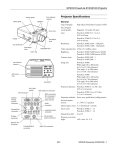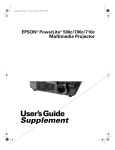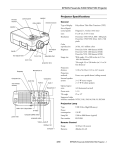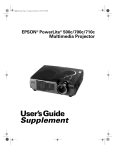Download Epson PowerLite 703C Specifications
Transcript
EPSON PowerLite 703c Projector Optical aspect ratio 4:3 (horizontal:vertical) lens ring remote control receiver speaker 1:1.2 Noise level 42 dB Keystone correction angle ±15° (maximum) focus ring foot release lever Projection Lamp Type UHE (Ultra High Efficiency) Power consumption 150 W foot foot release lever foot Zoom ratio Lamp life About 1000 hours Part number ELPLP14 lens cap Remote Control control panel buttons Range 32.8 feet (10 meters) Batteries Alkaline AA (2) Mouse Compatibility Supports PS/2, USB, ADB Dimensions indicator lights power inlet Kensington® lock port USB port computer connector A/V jacks PS/2 mouse port 2.8 to 3.4 inches (72 to 87 mm) Width 8.4 inches (213 mm) Depth 10.5 inches (267 mm) Weight 5.8 lb (2.6 kg) Electrical audio jacks S-Video connector Rated frequency 50 to 60 Hz Power supply 100 to 120 VAC, 1.9 A 200 to 240 VAC, 1.0 A Power consumption Projector Specifications Operating: 230 W Standby: 5 W Environmental General Type of display Height Temperature Poly-silicon Thin Film Transistor (TFT) Storage: 14 to 140 °F (–10 to 60 °C), Size of LCD panels Diagonal: 0.9 inch (22.9 mm) Lens F=2.0 to 2.2, f=35 to 42 mm Resolution 1024 × 768 pixels (native format) Operating: 41 to 95 °F (5 to 35 °C), Humidity Operating: 20 to 80% RH, non-condensing Storage: 10 to 90% RH, non-condensing Color reproduction 24 bit, 16.7 million colors Brightness 1000 lumens (ANSI) Safety Contrast ratio 320:1 United States Image size 26 to 300 inches FCC Part 15B Class B UL1950 Rev. 3 Canada DOC ICES003 Class B CSA C22.2 No. 950 Rev. 3 CE Marking Directive 89/336/EEC, 92/31/EEC EN 60950 Projection distance 3.6 to 45.5 feet (1.1 to 13.8 meters) Projection methods Front, rear, upside-down (ceiling mount) Internal sound system 1 W monaural 2/01 EPSON PowerLite 703c Projector - 1 EPSON PowerLite 703c Projector Compatible Video Formats Computer Connector Pin Assignments The projector supports NTSC, PAL, and SECAM international video standards, as well as the monitor display formats listed below. The Computer/Component video port is a female video RGB, 15-pin micro-D-style connector. The pin assignments are: To project images output from a computer, the computer’s video card must be set at a refresh rate (vertical frequency) that’s compatible with the projector; see the following table for compatible formats. As noted below, some images are automatically resized to display in one of the projector’s “native” formats (such as XGA). In addition, the frequencies of some computers may not allow images to display correctly; see your computer’s documentation for details. * Input pin Computer connector signals 1 Red video 2 Green video 3 Blue video 4 GND 5 GND Mode Refresh Rate (Hz) Resolution 6 Red GND VGAEGA 70 640 x 350 7 Green GND VGA60 VGA72 VGA75 VGA85 VGA Text VGA Text 59.94 72.809 75 85.008 70.087 70.087 640 x 480 640 x 480 640 x 480 640 x 480 720 x 350 720 x 400 8 Blue GND 9 Reserved 10 Synchronous GND 11 GND SVGA56 SVGA60 SVGA72 SVGA75 SVGA85 56.25 60.317 72.188 75 85.061 800 x 600 800 x 600 800 x 600 800 x 600 800 x 600 12 SDA 13 Horizontal sync/composite sync 14 Vertical sync 15 SCL XGA43i XGA60 XGA70 XGA75 XGA85 86.958 60.004 70.069 75.029 84.997 1024 x 768 1024 x 768 1024 x 768 1024 x 768 1024 x 768 SXGA1—70 SXGA1—75 SXGA1—85 70.012 75 84.999 1152 x 864* 1152 x 864* 1152 x 864* SXGA2—60 SXGA2—75 SXGA2—85 60 75 85.002 1280 x 960* 1280 x 960* 1280 x 960* SXGA3—43i SXGA3—60 SXGA3—75 SXGA3—85 86.871 60.02 75.025 85.024 1280 x 1024* 1280 x 1024* 1280 x 1024* 1280 x 1024* UXGA60 60 1600 x 1200* MACII13 MAC16 MAC19-60 MAC19 MAC21 66.67 75.087 59.28 74.93 75.062 640 x 480 832 x 624 1024 x 768 1024 x 768 1152 x 870* NTSC PAL SECAM 60 50 50 640 x 480* 720 x 540* 720 x 540* Projector Placement Guidelines ❏ Place the projector on a sturdy, level surface, between 3.6 and 45.5 feet from the screen. ❏ Make sure there is plenty of space for ventilation around and under the projector. ❏ Make sure the projector is within 6 feet of a grounded electrical outlet or extension cord and within 5 feet of your computer and/or video source. ❏ Place the projector directly in front of the center of the screen, facing it toward the screen squarely. Otherwise, your image will not be square. The image is resized so that it displays using one of the projector’s native formats. 2 - EPSON PowerLite 703c Projector 2/01 EPSON PowerLite 703c Projector Turning On the Projector Use the figure below as a guideline to help you determine how far from the screen to place the projector. Image size generally increases with distance, but may vary depending on how you position the lens ring and whether you have adjusted the image size with other settings. Follow these steps to plug in and turn on the projector: 1. Connect one end of the power cord to the projector’s power inlet. power light 38 to 45 ft 7 to 9 ft 3.6 to 4.3 ft distance from screen 2. Connect the other end to a grounded electrical outlet. If you place the projector below the level of the screen, you’ll have to tilt it up by extending the feet as shown. Tilting the projector upward causes the image to lose its square shape, but you can correct the distortion by pressing the Keystone button as described in the next chapter. The power light on top of the projector turns orange, indicating that the projector is receiving power but not yet turned on. 3. Use the tab on the lens ring to rotate the ring and extend the lens. tab ideal height 4. Squeeze the lens cap tabs and remove the lens cap. squeeze here If you place the projector level with the bottom of the screen, the image will be square and you won’t have to adjust it. If you place the projector higher than the bottom of the screen, the image will still be square, but you won’t be able to fill the whole screen with the image. Starting Up the Projector Caution: Do not use the projector with the lens cap in place. The heat generated by the lens can damage the cap. Make sure your projector and other equipment are set up and connected correctly. Then turn on your projector, as described below, followed by any equipment you’ve connected to it. You can turn on your computer and video equipment in any order, but if you have both a computer and video source connected, you may have to switch to the desired source as described on page 4. 2/01 EPSON PowerLite 703c Projector - 3 EPSON PowerLite 703c Projector 5. Press the red Power button on top of the projector. 2. Click the Arrange icon. Click here Power button power light Drag one monitor icon on top of the other The power light flashes green as the projector warms up, and the projection lamp comes on in about 30 seconds. The power light stays green. 3. Drag one monitor icon on top of the other. Warning: Never look into the lens when the lamp is on. This can damage your eyes, and is especially dangerous for children. If this option isn’t available, you may need to select one of the Simulscan resolution settings: 1. Click the Monitor icon. 6. Do one of the following: ❏ If you’re using a computer, turn it on or restart it. In a few moments, you should see your computer display projected. (Windows® only: If you see a message saying that it has found a plug-and-play monitor, click Cancel.) Click here ❏ If you’re projecting a video, press the Source button on top of the projector to switch to your video source, and press the Play button on your DVD player or other device. Select a Simulscan resolution If a projected image fails to appear, see the next section for help. 2. Select a Simulscan resolution as shown. (Allow a few seconds for the projector to sync up after making the selection.) What To Do If You See a Blank Screen If you’re using a PC laptop: If you see a blank screen or a blue screen with the message No Signal after turning on your computer or video source, try the following: ❏ Hold down the Fn key and press the function key that lets you display on an external monitor. It may have an icon such as or it may be labelled CRT/LCD. Allow a few seconds for the projector to sync up after pressing it. Check your laptop’s manual or online help for details. ❏ Make sure the cables are connected correctly. ❏ Make sure the power light is green and not flashing and the lens cover is off. On most systems, the key lets you toggle between the LCD screen and the projector, or display on both at the same time. ❏ Try restarting your computer. ❏ Press the Source button on top of the projector to select the correct source. (Allow a few seconds for the projector to sync up after pressing the button.) ❏ Depending on your computer’s video card, you might need to use the Display utility in the Control Panel to make sure that both the LCD screen and external monitor port are enabled. See your computer’s documentation or online help for details. If you’re using a PowerBook: You may need to set up your system to display on the projector screen as well as the LCD screen. Follow these steps: 1. From the Apple menu, select Control Panels, then click Monitors and Sound. 4 - EPSON PowerLite 703c Projector 2/01 EPSON PowerLite 703c Projector ❏ If your image looks like or , press the + or – side of the Keystone button to correct the shape of the image. After correction, your image will be slightly smaller. Focusing and Zooming Your Image Rotate the focus ring to sharpen the image. You can also perform electronic keystone correction using the projector’s Setting menu. lens ring tab focus ring Shutting Down the Projector When you’ve finished using the projector, follow the recommended procedure to shut it down. This extends the life of the lamp and protects the projector from possible overheating. Use the tab to rotate the lens ring and reduce or enlarge the image. You can also change the image size by moving the projector closer to or farther away from the screen. You can use the E-Zoom button on the remote control to zoom in on a portion of the image. See page 5 for instructions. Note: When the projector has not received any input signals for 30 minutes, it automatically turns off the projector lamp and enters “sleep mode.” This conserves electricity, cools the projector, and extends the life of the lamp. If you are done using the projector, unplug the power cord. If you want to start projecting again, press the Power button. Adjusting the Height of Your Image If the image is too low, you can raise it by extending the projector’s feet. 1. If you’re using a computer, shut it down first. 1. Stand behind the projector. Pull up the blue foot release levers and lift the front of the projector. This unlocks the feet. 2. To turn off the projector, press the red Power button on the projector or remote control. You see a confirmation message. (If you don’t want to turn it off, press any other button.) Power button power light Caution: Do not hold the projector by the lens; this can damage it. 3. Press the Power button again. The power light flashes orange for about a minute as the projector cools down. When the projector has cooled, the orange light stays on and the exhaust fan shuts off. 2. Once the image is positioned where you want it, release the levers to lock the feet in position. 3. To fine-tune the height of the image, rotate the thumb wheels attached to the projector’s feet. If you want to turn the projector on again, wait until the orange light stops flashing. Then press the Power button. If the image is no longer square after raising it, see the next section. 4. Replace the lens cap, retract the lens, and unplug the power cord. Caution: To avoid damaging the projector or lamp, never unplug the power cord when the power light is green or flashing orange. Adjusting the Image Shape If the projected image isn’t square or has a “keystone” shape, do one or more of the following: 5. If you’re using a VCR or other video source, turn it off after you turn off the projector. ❏ If your image looks like or , you’ve placed the projector off to one side of the screen, at an angle. Move it directly in front of the center of the screen, facing the screen squarely. 6. Disconnect all equipment, and store the projector in the bag that came with it or in a protective case. 2/01 EPSON PowerLite 703c Projector - 5 EPSON PowerLite 703c Projector Projector Status Lights Using the Remote Control The remote control lets you access all of your projector’s features from anywhere in the room (up to 30 feet away). You can use it to turn the projector on and off, zoom the image, and highlight your presentation, for example. IR output power light lamp light Power Freeze temperature light A/V Mute Freeze E-Zoom R/C ON OFF E-Zoom 3 2 Remote control on/off 4 1 5 Special highlighting effects buttons The lights on top of the projector indicate the projector’s status and let you know when a problem occurs. Power A/V Mute Enter Enter Illumination Description and action orange The projector is in sleep mode. You can unplug it or press the Power button to turn it on. flashing green The projector is warming up. Wait for the image to appear. green The projector is operating normally. flashing orange The projector is cooling down. You can’t turn the projector on (and should not unplug it) until the light stops flashing and remains orange. red Power is cut off because of an internal problem. Remove the power cord and contact EPSON for help. flashing orange The lamp is almost burned out. This is a good time to replace it, following the instructions on page 8. red The lamp is burned out. Replace it as described on page 8. flashing red There is a problem with the lamp, power supply, fuse, or circuit. If necessary, replace the lamp as described on page 8. flashing orange Open the cover just below the Esc button to access these remote control functions: Enter Esc The projector is overheating, which turns off the lamp automatically. Let it cool for a few minutes, then turn it back on. Make sure there is plenty of space around and under the projector for ventilation. If it continues to overheat, you may need to change the air filter. See page 8 for instructions. flashing red There is a problem with the cooling fan or temperature sensor. Turn off the projector and unplug it. Contact EPSON for help. 6 - EPSON PowerLite 703c Projector Menu Help Comp EasyMP Menu Help Comp S-Video Auto The projector is too hot. Make sure the temperature surrounding the projector does not exceed 104 °F and there is plenty of space around and under the projector for ventilation. Clean the air filter if necessary. See page 8 for instructions. red Esc Esc 5 Status 1 Light Picture in picture S-Video Video Auto Resize P in P - Volume + 2/01 Video Resize Volume EPSON PowerLite 703c Projector This table summarizes the functions on the remote control. Button Function Power Starts or stops the projector. Freeze Keeps the current computer or video image on the screen. A/V mute Turns off the audio and video, displaying the black, blue, or user logo background. E-Zoom Enlarges or reduces the image size from 1x to 4x (in 12 steps). Pressing the right side of the button enlarges the image, pressing the left side of the button reduces the image. To display a portion of an enlarged image which is outside the display area, press the Enter button and scroll the image to the desired location. Using the Buttons Power Source Enter Help Keysto ne Select The following table summarizes the functions of the buttons on top of the projector: Button Function Places a pointer or cursor stamp on the screen. Power Starts or stops projection. Draws a box highlight. Help Displays the online help menu. Button 3 Draws a horizontal or vertical bar. Source Button 4 Draws a freehand line. Switches between Computer, Video, and S-video sources. Button 5 Erases highlighting effects. Enter Enter (pointer button) Use the Enter button to navigate the menus or to use the remote as a mouse pointer when the projector is connected to a computer with the mouse cable. The Enter button acts as a mouse left-click. Selects a menu option when the Help menu is displayed. – Keystone + Adjusts a trapezoid distorted image to normal, correction up to a ±15° tilt. Select Illumination Illuminates all buttons on the remote control. Scrolls through options when the Help menu is displayed. Esc Stops the current function. Pressing Esc while viewing a menu displays the previous menu. When the image source is Computer, the Esc button acts as a mouse right-click. R/C ON/OFF Turns the remote control on or off. Button 1 Button 2 Cleaning the Lens Menu Displays or hides the menu. Comp Switches to Computer image. Clean the lens whenever you notice dirt or dust on the surface. S-Video Switches to S-video image. ❏ Use a canister of compressed air to remove dust. Auto Optimizes the computer image. P in P Displays a video or S-video image in a subscreen on the main display. Use the Enter button to reposition the Picture in Picture (P in P) screen, or the E-Zoom button to enlarge or reduce the image. Changes made to the P in P screen location and size are automatically carried over to the next P in P session. ❏ To remove dirt or smears on the lens, use lens-cleaning paper. If necessary, moisten a soft cloth with lens cleaner and gently wipe the lens surface. Help Displays the online help menu. Video Switches to Video image. Resize Switches the display dot mode and resize mode for VGA, UXGA, SVGA, and SXGA input. Switches the aspect ratio between 4:3 and 16:9 when video images are being projected. – Volume + Adjusts the volume. Extend the lens and remove the cap before cleaning Note: The projector might not respond to remote control commands in these conditions: the R/C (remote control) ON/OFF switch is in the OFF position; batteries are weak; ambient light is too bright; a certain type of fluorescent light is present; a strong light source (such as direct sunlight) shines into the infrared receiver; or other equipment emitting infrared energy is present (such as a radiant room heater). Correct these conditions to use the remote control. 2/01 EPSON PowerLite 703c Projector - 7 EPSON PowerLite 703c Projector Note: When you get a replacement lamp for your projector, a new air filter is included. You should replace the filter when you replace the lamp. Cleaning the Projector Before you clean the case, first turn off the projector and unplug the power cord. 5. To install the new filter, first insert the tab, then press down until it clicks in place. ❏ To remove dirt or dust, wipe the case with a soft, dry, lintfree cloth. ❏ To remove stubborn dirt or stains, moisten a soft cloth with water and a neutral detergent. Then wipe the case. Replacing the Lamp ❏ Do not use wax, alcohol, benzene, thinner, or other chemical detergents. These can damage the case. The projection lamp typically lasts for about 1000 hours of use. It is time to replace the lamp when: ❏ The projection image gets darker or starts to deteriorate. ❏ The lamp warning light orange. Cleaning and Replacing the Air Filter is red, flashing red, or flashing Clean the air filter on top of the projector after every 100 hours of use. If it is not cleaned periodically, it can become clogged with dust, preventing proper ventilation. This can cause overheating and damage the projector. ❏ The message LAMP REPLACE appears on the screen when the lamp comes on (after about 900 hours of use). To maintain projector brightness and image quality, replace the lamp as soon as possible. 1. Turn off the projector, allow it to cool down, and unplug the power cord. Contact your dealer or EPSON for a replacement lamp. Request part number ELPLP14. 2. Stand the projector on end to keep dust from falling inside. Follow these steps to replace the lamp: 3. To clean the filter, EPSON recommends using a small vacuum cleaner designed for computers and other office equipment. If you don’t have one, gently clean the filter using a very soft brush (such as an artist’s camel-hair brush). 1. Turn off the projector, then unplug the power cord. 2. Allow the projector to cool down for at least half an hour (if it has been on). Warning: Let the lamp cool before replacing it. If the lamp breaks, handle the shards carefully to avoid injury. 3. Turn the projector upside-down to access the lamp compartment. 4. Use a screwdriver to loosen the retaining screw on the lamp cover. (You can’t remove the screw from the cover.) When the screw is loose, lift off the lamp cover. ) If the dirt is difficult to remove or if the filter is torn, replace it. Contact your dealer or EPSON to obtain a new one. 4. To replace the filter, use a small screwdriver to pry it off. 8 - EPSON PowerLite 703c Projector 2/01 EPSON PowerLite 703c Projector 5. Use a screwdriver to loosen the two screws holding the lamp in place. (You can’t remove these screws.) Optional Accessories 6. Lift up the wire handle, as shown, and pull the lamp straight out. Product Product number Replacement lamp and air filter ELPLP14 Soft carrying cases: Samsonite® wheeled soft case Slimline soft shoulder bag Notebook/projector soft shoulder bag ATA molded hard shell case ELPKS35 ELPKS31 ELPKS32 ELPKS30 Ceiling mount ELPMB32 Suspension adapter for ceiling mount (1-inch pipe) ELPMBAPS Suspension adapter for ceiling mount (1.5-inch pipe) ELPMBAST Kensington MicroSaver® security lock ELPSL01 7. Gently insert the new lamp. Portable projection screens: 50-inch screen 60-inch Insta-Theatre screen 80-inch Insta-Theatre screen ELPSC06 ELPSC07 ELPSC08 8. Once the lamp is fully inserted, tighten its screws. Wireless microphone and two satellite speakers ELPCVS1 9. Replace the lamp cover and tighten its screw securely. (The projector won’t come on if the lamp cover is loose.) Presentation audio system ELPPAS1 Macintosh adapter set (includes monitor adapter and desktop adapter) ELPAP01 VGA to 13W3 video cable (for connecting to certain high-end workstations) ELPKC06 handle Caution: Do not touch the glass portion of the lamp assembly. Touching the glass could result in premature lamp failure. Related Documentation 2/01 CPD-11727 EPSON PowerLite 703c User’s Guide CPD-11728 EPSON PowerLite 703c Quick Setup sheet Service Manual TM-EMP703c Parts Price List PL-EMP703c EPSON PowerLite 703c Projector - 9









